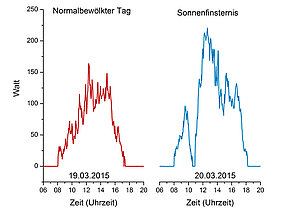The <link internal-link internal link in current>solar system on the roof ot the MPI CEC measured significant effects of the solar eclipse on the production of electricity.
The graphs in the figure show the amount of current produced by the institute’s photovoltaic system from 6am to 8pm on Thursday, March 19th and Friday, March 20th (day of the solar eclipse).
The x-axis shows the time from 6am to 8pm, the y-axis the amount of current in watt (W).
On both days the weather was very similar with a cloudy and overcast sky, so you can compare both days. The graphs show how the sun started to shine and lighted up the sky around 8am, as the solar system produced more and more electricity. At noon, around 1pm, when the sun was at its highest, the amount of current reached its maximum. On Friday, March 20th the weather was a little bit sunnier than the weather on the day before (March 19th), so the peak is also a little bit higher. But considering that the solar system is able to produce a maximum of 2000 Watt on a sunny day and it produced just around 200-250 Watt on these cloudy days, you can see that both days were clouded and over casted equally and therefore comparable to each other.
In some parts of NRW, for example in Mülheim, it was not possible to witness the solar eclipse, the dense blanket of clouds covered the view on the phenomenon. Nevertheless there were significant losses in the production of electricity by the solar system on the roof of the institute. As the graph of Friday (March 20th) shows, there was no production during the maximum of the partial solar eclipse (in Mülheim around 10:40am). From 11am the wattage rose again until the end of the solar eclipse around 11:50am up to a normal level (for a cloudy day).
Although the solar eclipse were not visible for the own eyes the figure shows in a significant way that the solar irradiation decreased considerably.

